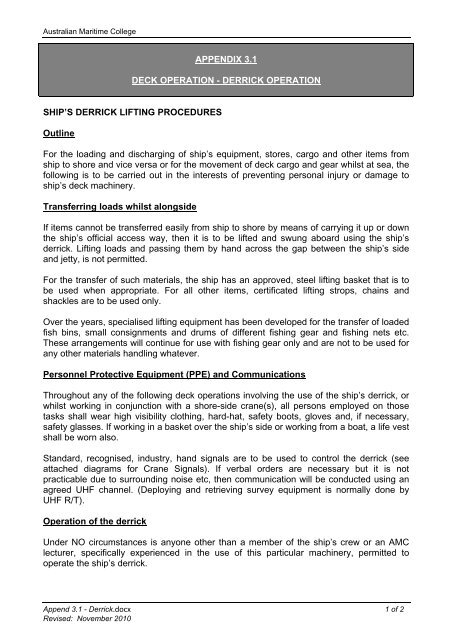MV BLUEFIN QUALITY MANUAL - Australian Maritime College
MV BLUEFIN QUALITY MANUAL - Australian Maritime College
MV BLUEFIN QUALITY MANUAL - Australian Maritime College
Create successful ePaper yourself
Turn your PDF publications into a flip-book with our unique Google optimized e-Paper software.
<strong>Australian</strong> <strong>Maritime</strong> <strong>College</strong><br />
APPENDIX 3.1<br />
DECK OPERATION - DERRICK OPERATION<br />
SHIP’S DERRICK LIFTING PROCEDURES<br />
Outline<br />
For the loading and discharging of ship’s equipment, stores, cargo and other items from<br />
ship to shore and vice versa or for the movement of deck cargo and gear whilst at sea, the<br />
following is to be carried out in the interests of preventing personal injury or damage to<br />
ship’s deck machinery.<br />
Transferring loads whilst alongside<br />
If items cannot be transferred easily from ship to shore by means of carrying it up or down<br />
the ship’s official access way, then it is to be lifted and swung aboard using the ship’s<br />
derrick. Lifting loads and passing them by hand across the gap between the ship’s side<br />
and jetty, is not permitted.<br />
For the transfer of such materials, the ship has an approved, steel lifting basket that is to<br />
be used when appropriate. For all other items, certificated lifting strops, chains and<br />
shackles are to be used only.<br />
Over the years, specialised lifting equipment has been developed for the transfer of loaded<br />
fish bins, small consignments and drums of different fishing gear and fishing nets etc.<br />
These arrangements will continue for use with fishing gear only and are not to be used for<br />
any other materials handling whatever.<br />
Personnel Protective Equipment (PPE) and Communications<br />
Throughout any of the following deck operations involving the use of the ship’s derrick, or<br />
whilst working in conjunction with a shore-side crane(s), all persons employed on those<br />
tasks shall wear high visibility clothing, hard-hat, safety boots, gloves and, if necessary,<br />
safety glasses. If working in a basket over the ship’s side or working from a boat, a life vest<br />
shall be worn also.<br />
Standard, recognised, industry, hand signals are to be used to control the derrick (see<br />
attached diagrams for Crane Signals). If verbal orders are necessary but it is not<br />
practicable due to surrounding noise etc, then communication will be conducted using an<br />
agreed UHF channel. (Deploying and retrieving survey equipment is normally done by<br />
UHF R/T).<br />
Operation of the derrick<br />
Under NO circumstances is anyone other than a member of the ship’s crew or an AMC<br />
lecturer, specifically experienced in the use of this particular machinery, permitted to<br />
operate the ship’s derrick.<br />
Append 3.1 - Derrick.docx 1 of 2<br />
Revised: November 2010


